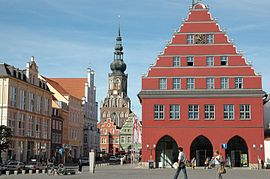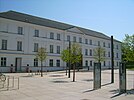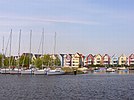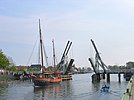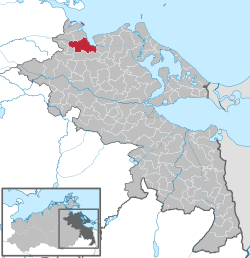
Back Greifswald Afrikaans Greifswald AN غرايفسفالد Arabic قرایفسوالد AZB Грайфсвальд Byelorussian Грайфсвалд Bulgarian Greifswald Breton Greifswald Catalan Greifswald (munisipyo) CEB Greifswald Czech
Greifswald | |
|---|---|
Clockwise from top: town hall and St Nicholas' Church, Pomeranian State Museum, drawbridge over the Ryck, view of the city with St Mary's, St Nicholas' and St James', new harbour and Holzteichquartier (woodpond borough), ruins of Eldena (Hilda) Abbey | |
| Coordinates: 54°5′N 13°23′E / 54.083°N 13.383°E | |
| Country | Germany |
| State | Mecklenburg-Vorpommern |
| District | Vorpommern-Greifswald |
| Subdivisions | 8 boroughs |
| Government | |
| • Lord mayor (2022–29) | Stefan Fassbinder[1] |
| Area | |
| • Total | 50.50 km2 (19.50 sq mi) |
| Elevation | 5 m (16 ft) |
| Population (2022-12-31)[2] | |
| • Total | 59,691 |
| • Density | 1,200/km2 (3,100/sq mi) |
| Time zone | UTC+01:00 (CET) |
| • Summer (DST) | UTC+02:00 (CEST) |
| Postal codes | 17489-17493 |
| Dialling codes | 03834 |
| Vehicle registration | HGW |
| Website | www.greifswald.de |
Greifswald (German pronunciation: [ˈɡʁaɪfsvalt] ⓘ), officially the University and Hanseatic City of Greifswald (German: Universitäts- und Hansestadt Greifswald, Low German: Griepswoold, Kashubian: Grifiô) is the fourth-largest city in the German state of Mecklenburg-Western Pomerania after Rostock, Schwerin and Neubrandenburg. In 2021 it surpassed Stralsund for the first time, and became the largest city in the Pomeranian part of the state. It sits on the River Ryck, at its mouth into the Danish Wiek (Dänische Wiek), a sub-bay of the Bay of Greifswald (Greifswalder Bodden), which is itself a sub-bay of the Bay of Pomerania (Pommersche Bucht) of the Baltic Sea.
It is the seat of the district of Western Pomerania-Greifswald, and is located roughly in the middle between the two largest Pomeranian islands of Rugia (Rügen) and Usedom. The closest larger cities are Stralsund, Rostock, Szczecin and Schwerin. It lies west of the River Zarow, the historical cultural and linguistic boundary between West (west of the river) and Central Pomerania (east of the river). The city derives its name from the dukes of Pomerania, the House of Griffin (Greifenherzöge), and thus ultimately from the Pomeranian Griffin (Pommerscher Greif), and its name hence translates as "Griffin's Forest".
The University of Greifswald, which was founded in 1456, is the second-oldest university in the Baltic Region after the University of Rostock. The city is well-known for the ruins of Eldena Abbey (formerly Hilda Abbey), a frequent subject of the paintings of Caspar David Friedrich, who was born in the city when it was part of Swedish Pomerania. Greifswald is the seat of the Pomeranian State Museum (Pommersches Landesmuseum). The recently built Ryck Barrier (Rycksperrwerk) protects the city from exceptionally high tides and storm surges moving up from the Baltic.
The city's population was listed at 59,332 in 2021, including many of the 12,500 students and 5,000 employees of the University of Greifswald. Greifswald draws international attention due to the university, its surrounding BioCon Valley, the Nord Stream 1 gas pipeline which ends at nearby Lubmin, and the Wendelstein 7-X nuclear fusion projects.
- ^ Kommunalwahlen in Mecklenburg-Vorpommern, Ergebnisse der Bürgermeisterwahlen, Mecklenburg-Vorpommern, Landesamt für innere Verwaltung, accessed 13 November 2022.
- ^ "Bevölkerungsstand der Kreise, Ämter und Gemeinden 2022" (XLS) (in German). Statistisches Amt Mecklenburg-Vorpommern. 2023.
© MMXXIII Rich X Search. We shall prevail. All rights reserved. Rich X Search
